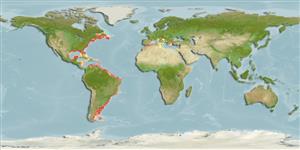Bivalvia |
Ostreida |
Ostreidae
Environment: milieu / climate zone / depth range / distribution range
Ecology
Benthic; brackish; depth range 0 - 79 m (Ref. 83435). Subtropical, preferred 22°C (Ref. 107945)
Western Atlantic and the Mediterranean. Introduced in Northeast Atlantic and the Pacific Ocean.
Length at first maturity / Size / Weight / Age
Maturity: Lm ? range ? - ? cm Max length : 30.0 cm SHH male/unsexed; (Ref. 271); max. reported age: 2.00 years (Ref. 2823)
Diagnostic features: Shell thick and heavy, usually narrow and elongate, but extremely variable in shape. Upper valve flatter, smaller than lower valve; lower valve convex. Shell shape and outline variable. Shell margins undulating straight. Umbones long and curved. Colour: dirty to light grey, internally white with muscle scar deep purple (Ref. 271).
################ Attached to rocks, other oyster shells, or other hard substrates (Ref. 271). Favors estuaries and embayments with low salinities and are intolerant of prolonged exposure to fresh water or marine conditions. They may either be filter feeders (Ref. 96280) or suspension feeders (Ref. 3248). Found in shallow water of tidal to subtidal depth of fairly constant turbidity and salinity (Ref. 3248) and salt marshes (Ref. 2823). Main sources of food are phytoplankton, suspended detritus particles (Ref. 96280) and bacteria (Ref. 101343). Able to regulate its feeding rates based on differences in size, type and composition of the food source (Ref. 96280).
Life cycle and mating behavior
Maturity | Reproduction | Spawning | Eggs | Fecundity | Larvae
Gonochoristic (separate male and females). After external fertilization, the developing larvae or veliger settles to the bottom after a time in the plankton stage. First spawning usually occurs when oyster is two years of age (Ref. 3248).
Carpenter, K.E. (ed.). 2002. (Ref. 271)
IUCN Red List Status (Ref. 130435)
CITES status (Ref. 108899)
Not Evaluated
Not Evaluated
Threat to humans
Human uses
Fisheries: commercial; aquaculture: commercial
FAO - Aquaculture: production, species profile; Fisheries: landings, species profile | FishSource | Sea Around Us
Tools
Internet sources
Estimates based on models
Preferred temperature
(Ref.
115969): 7.7 - 27.5, mean 23.5 (based on 794 cells).
Prior r = 0.72, 95% CL = 0.47 - 1.07, Based on 1 full stock assessment.
Vulnerability
Low to moderate vulnerability (27 of 100).
Nutrients: Calcium = 149 [71, 228] mg/100g; Iron = 8.53 [1.95, 15.11] mg/100g; Protein = 9.88 [8.64, 11.12] %; Omega3 = 0.313 [0.202, 0.423] g/100g; Selenium = 61 [50, 72] μg/100g; VitaminA = 0 μg/100g; Zinc = 2.04 [0.56, 3.51] mg/100g (wet weight).
